|
|
Blog Archives:
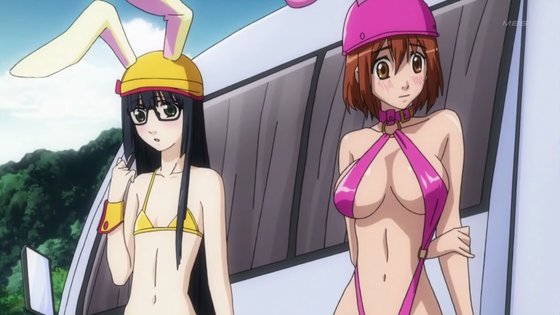
These are the worst disguises, ladies.
Remember that part in the movie Beautiful Girls where they talk about tits and asses? Not the scene with the preternaturally precocious Natalie Portman, but the one with Rosie O'Donnell arguing about how God is fair.
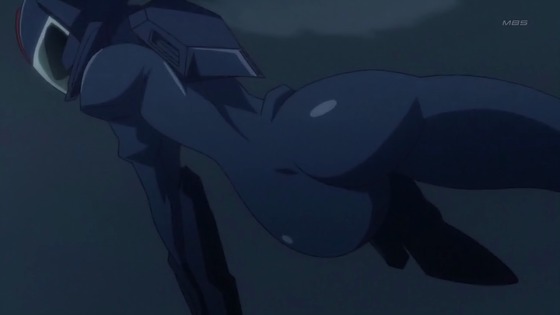
Evil is such a strong word.
Yeah, apparently Futaba Aoi never got that memo. Either that or I've discovered where that suit hides its power source.
In other news, I don't understand why Aoi doesn't use that teleportation power of hers to snatch weapons and bomb triggers away from her opponents.
Posted in Asobi ni Iku yo! | Tags: ASS SHOT OF THE YEAR, Fan Service, GIRL NEXT DOOR, Girls With Guns, Hanazawa Kana, Harem Comedy, Haruka Tomatsu, Hime Cut, Summer 2010 | Permanent Link
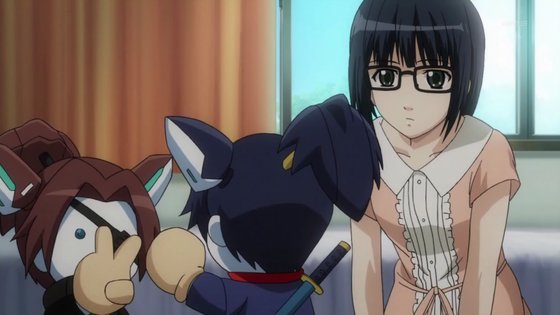
And I'm not talking about Aoi's birth-control glasses.
I was initially confused because at first I thought Chiba was the one that won. In other news, I love Aoi's appearance here. Look at the way she's dressed, for crying out loud.
Posted in Asobi ni Iku yo! | Tags: Girls With Guns, Harem Comedy, Hime Cut, Summer 2010 | Permanent Link
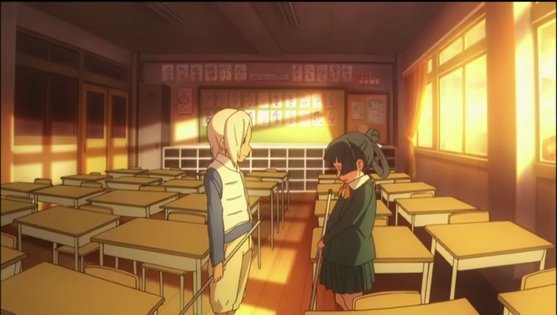
Try a little tenderness, Urashima.
The Ayako Doctrine doesn't compel viewership, but it does compel consideration. In the case of Ookami-san, being the only source for Kawasumi Ayako in the summer of 2010, I stayed with the show too long. Granted, it had an amusing first episode, but that second episode was God awful—easily the single worst episode of anything I've seen this season. The third episode was actually a nice bit of storytelling with some parallels to the fable about the ugly duckling, and the fourth episode even focused primarily on Ayako's character, but it's not enough. I stayed with the show through five episodes—long enough to determine Ookami-san to Shichinin no Nakama-tachi just didn't have anything worth watching, even with the Kawasumi Ayako + Horie Yui + legs-that-go-up-to-her-neck trifecta. I'm done with it.
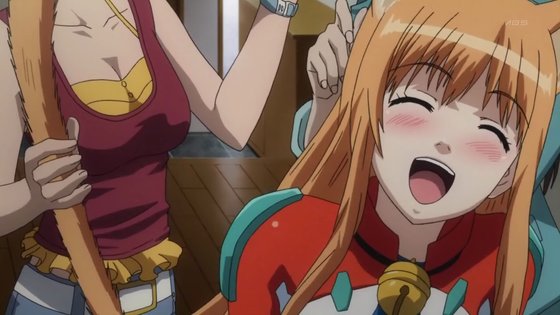
Asobi ni Iku yo! is awesome because it is preposterous.
On the other hand, Asobi ni Iku yo! is amazing. Why didn't anyone tell me this show was actually good? I was sold when I found out the Girl Next Door was a crazy stalker. Also it has guns and cars. And swarming robots with "..." signs.
Posted in Asobi ni Iku yo!, Ookami-san to Shichinin no Nakama-tachi, WORSE THAN COSPRAYERS | Tags: AYAKO DOCTRINE, Built for Sin, Dropped Shows, Fan Service, GIRL NEXT DOOR, Girls With Guns, Hair, Harem Comedy, Hime Cut, Legs that go up to her neck, Summer 2010, Try a Little Tenderness, tsundere, Yui Horie | Permanent Link

At least there's no spinning watermark.
Although I own all the DVDs, I chose to re-watch my archive of Love Hina fansubs over the past few months. As you might expect, the video and audio quality is atrocious by modern standards, with 320x240 15fps encodes being the norm. (The entire season fits on two CD-Rs.) Depending on the group, the subtitles themselves can also be quite poor by today's standards. Many lines are poorly timed and some episodes were clearly finished by non-native English speakers. Every single episode was generally inferior from a technical perspective than the samples in my recent Chu-Bra!! PSP experiment. Nevertheless, Love Hina in this crude form invokes a certain nostalgia when remembering the brief, recent history of anime distribution in America.
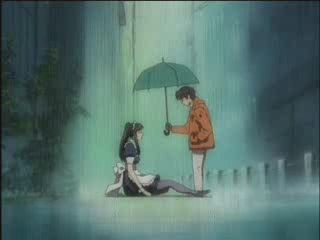
Try a little tenderness, Keitaro.
Love Hina was one of the first shows successfully distributed widely in entirely digital formats. Although the initial rips came from analog broadcasts, the Internet (and sneakernet) distribution of Love Hina episodes was accomplished digitally. Heretofore, American anime fans typically purchased, traded, or copied videotapes of fansubs. This is how I first watched All Purpose Cultural Cat Girl Nuku Nuku, for example. For those unfamiliar with the medium, videotapes are purely analog, so the quality degrades significantly after each generation. If you were lucky, you got to watch something that was low enough on the copy-of-a-copy-of-a-copy chain that it did not look like mush.

Aneue > Onee-sama.
What a long way we've come in merely a decade. Fansubs today appear with soft-subs that can be turned off and video quality that surpasses DVD limitations by a large margin. No wonder the anime DVD bubble collapsed so quickly. I, like many buyers, contracted my buying habits once DVDs became clearly inferior to recordings of initial broadcasts—waiting for Blu-ray releases. I'm still waiting. FUNimation is taking cautious steps, but I won't be cajoled long by lackluster upscales.
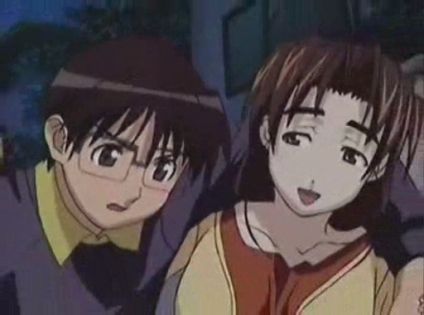
Keitaro's dilemma at the end of Love Hina is not
unlike Shinji's struggle with Instrumentality.
So what about Love Hina itself? Many former fans have recanted their affection for the title, disclaiming, "I hadn't seen much anime at that time, so I didn't know better." I still find Love Hina as charming and funny as ever. It balances a winning combination of absurd mechanized turtles and emotional resonance. It's a relic from a time of the big-boobed tsundere (before the stereotype turned into a complete joke), to be sure, and its harem comedy roots were unoriginal even then, but its cast remains engaging. Megumi Hayashibara is still absolutely dead-on as Aunt Haruka, and a round or two with Motoko reminds me how sorely Asakawa Yuu is missed. Likewise, the motif about promises still rings true today; it carries more import than the typical canned motivations anime characters generally spout. And perhaps it also implores viewers to remember a past they once loved and should not forget.
Posted in Loot, Love Hina | Tags: Harem Comedy, Hime Cut, History, Megumi Hayashibara, PSP Experiment, Try a Little Tenderness, tsundere, Yui Horie | Permanent Link
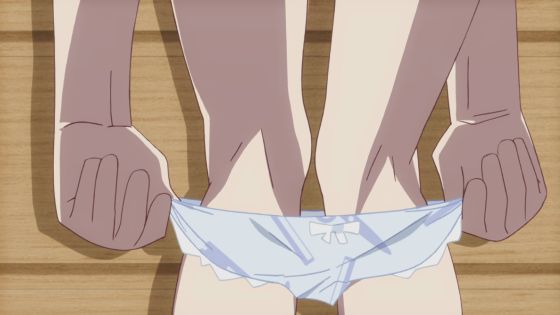
Hitagi pulls on her panties.
So, in light of Zan Sayonara Zetsubou Sensei episode 13, do you suppose SHAFT intentionally had Hitagi in Bakemonogatari episode two put on her panties backwards?
Posted in Bakemonogatari, Zan Sayonara Zetsubou Sensei | Tags: Built for Sin, Characters in Need of Better Shows, Hime Cut, Legs that go up to her neck, SHAFT X SHINBO, Summer 2009, Superlovely Character Designs | Permanent Link

I dropped Kiddy Girl-and at episode nine for trying to add a plot.
By convention, anime bloggers seem obligated to offer end-of-season summaries breaking down the finer points of the shows they watched and presumably covered (hah!) over each three-month block (or cour). So be it.
The short version is as follows: Kimi ni Todoke (12) > Cross Game (38) > Fullmetal Alchemist: Brotherhood (38) > Miracle Train [13] > Seitokai no Ichizon [12] > The Book of Bantorra (14) > Queen's Blade II [12] > Sunred II (37) > Fresh Pretty Cure (45), where the number in parentheses represents the last episode watched, and numbers in brackets indicate completion of a series and its total number of episodes. No OVAs or movies are included in these rankings.
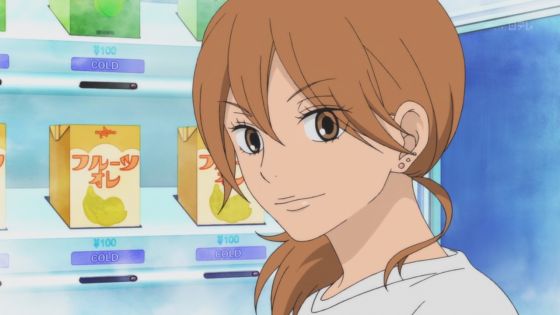
I'm calling it: Yano is pure evil.
Kimi ni Todoke veers into melodramatic territory frequently and its reception has grown increasingly polarized. Depending on your stomach for such shows, it's either excellent or unwatchable—at least that's the way it seems when comparing various reactions to the series. I find it excellent. Also, those of you who know Mamiko Noto from interviews, behind-the-scenes specials, and commentary tracks will reasonably conclude both her Shimako-variety and DARK MAMIKO personas (more on that later) are purely products of acting. Evil Miyuki Sawashiro, on the other hand, I'm convinced is the real deal. I'll never look at Puchiko the same way again. Anyway, I'm glad Kimi ni Todoke is getting another cour. It has sympathetic leads and villains I don't hate.

This is as close as you'll get to seeing Aoba tearing her clothes off.
Cross Game and its Mitsuru Adachi storytelling remains as compelling as ever, although it's probably a comment on the state of today's anime trends that I find a simple heterosexual romance to be a refreshing departure from the usual feuds among turbo lesbians and loathsome harem comedy leads. However, if you're familiar with Adachi's staples, you may find Cross Game a little too familiar. E.g., there will be no great happiness for the characters (and Aoba and Ko aren't going to start tearing each other's clothes off anytime soon), but at least one moment of tragedy or despair is assured (as is appropriate for baseball). Despite the sports theme, Cross Game is best as a relationship drama and light comedy, and succeeds because it plays to these strengths.
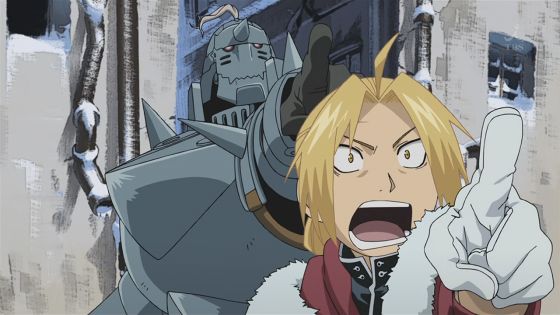
"Whoa, look at the size of that cat!"
Fullmetal Alchemist: Brotherhood is good shounen/mainstream fare without the odious shounen jive conventions one typically finds attached to shows aimed at such audiences. This anime variant, more faithful to the original manga than the first Fullmetal Alchemist, retains the interesting characters and periodic plot twists that made the first series so popular. Really, at this point, Brotherhood is at least as good as the first anime—if not better—and deserves more attention from the crowd that dismissed it early on as a simple rehash of something they had already seen.
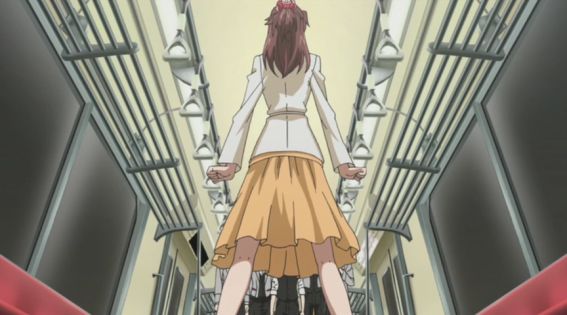
There is no escape from the Miracle Train, sweetie.
Miracle Train turned out to be a lot less gay than I was expecting. In fact, homosexual overtones were almost entirely absent, despite the show's outward appearance. Instead, what Miracle Train really seems like is some manner of train gang rape porn. Basically every episode some girl gets on a train and is immediately surrounded by men who won't let her off until they've "solved her problems." Usually the girl offers token resistance, but eventually relents and actually enjoys "having her problems solved" in the end. It's a ridiculous concept, punctuated by copious amounts of train and train station trivia, a token loli, and a talking dog that sounds suspiciously like Athrun Zala wondering what in Hell he's supposed to do this time about the man in the mask. Still, I'm glad I watched the entire series, and the later episodes contained the right mix of seriousness and sentimentalism.
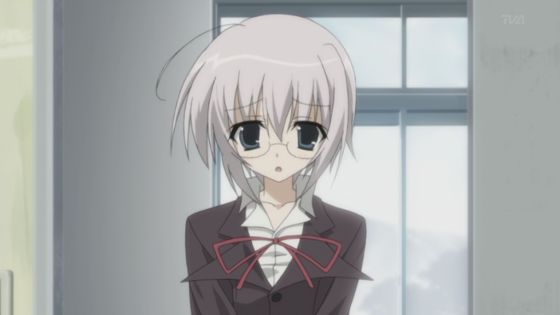
This is really a girl, isn't it? He has a ribbon.
Seitokai no Ichizon was all right even if it relied too much on reference humor. It had good comic timing, amusing characters, and never aspired to be much more than what it was.
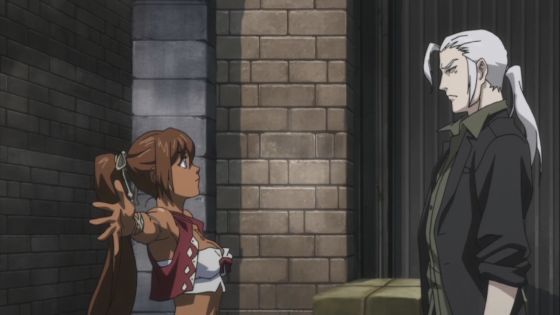
"I want you to hit me as hard as you can."
The Book of Bantorra is worth watching just because it's different. I liked the way the first arc played out, although Ayako Kawasumi's departure from the show is sorely missed. Well, they did bring her back to narrate the clip show in episode 14. Besides that, Noloty deserves to be on the short list of dark-skinned anime characters, Mirepoc has ridiculous-yet-awesome hair, and the strongest character on the show is the woman who is really good at hucking rocks. How can you not like that shit?
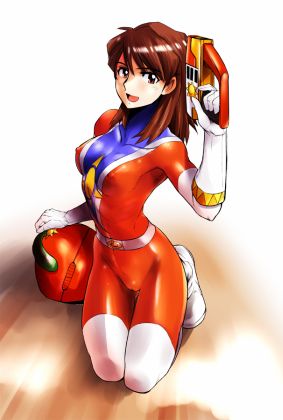
Kayoko fan art is goggled.
Sunred II is basically just more of the same. I like parody, but the jokes are becoming a little one-note. At this point I'd rather they just make the entire thing a bachelor-chow cooking show with Kayoko and Vamp punctuated by occasional household tips.
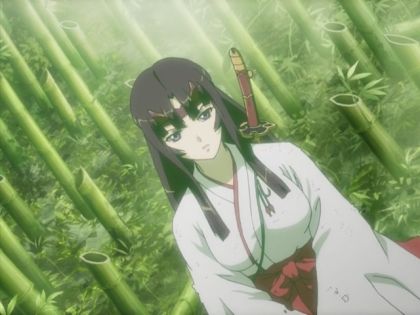
The horns mean Tomoe is serious. Dead serious.
I realize this is fairly qualified praise, but Queen's Blade II is far and away superior to the first season. For one thing, there's a lot less peeing. But the real gem is discovering why Mamiko Noto has been playing Tomoe so seriously all this time. The return of DARK MAMIKO is a welcome surprise albeit one only familiar to those who realized it was her in Dai Mahou Touge and perhaps those who enjoyed the final scenes of her character in the Kara no Kyoukai movies. (Note: DARK MAMIKO is not to be confused with her Ana Coppola Black Custom variant.) But really, Queen's Blade II develops a plot AND character development which is enough to elevate this ridiculous show to at least non-ironic watchable levels, even if the vast majority of its cast—unusually professional Mamiko Noto aside—completely phoned in their roles. Tanaka Rie, for example, was terrible.
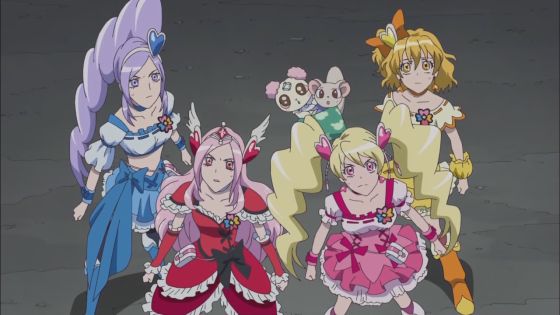
Lay off the meth, girls.
Fresh Pretty Cure is treading water and has been mostly lackluster since the end of the Cure Passion arc. Retconning Setsuna into a 14-year-old girl was not unexpected, but still inexcusable from a storytelling viewpoint. The addition of a fourth Cure diminished the importance of Cure Pine and Cure Berry and Cure Redundant. Wait, I mentioned her already. I maintain that Precure as a franchise works best with two Cures—no more, no less.
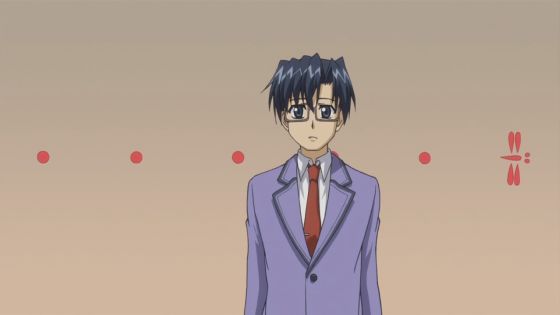
What about Nogizaka Haruka no Himitsu: Purezza?
Dropped at episode eight for being piss awful.
Was Autumn 2009 weaker than most seasons? I'd have to say so. Granted, I didn't watch Darker Than Black II or Railgun, both very highly regarded shows (although I suspect Railgun will be another ephemeral flash in the pan everyone disregards when the next shiny thing comes along), but aside from the refreshing Kimi ni Todoke and the briefly euphoric return of DARK MAMIKO in Queen's Blade II, I can't claim there will be much unique to Autumn 2009 alone that I will remember or recommend without reservation, alas.
Posted in Book of Bantorra, The, Cross Game, Fresh Pretty Cure, Fullmetal Alchemist: Brotherhood, Kiddy Girl-and, Kimi ni Todoke, Miracle Train, Nogizaka Haruka no Himitsu, Queen's Blade, Season Summary, Seitokai no Ichizon, Sunred | Tags: Autumn 2009, AYAKO DOCTRINE, baseball, DARK MAMIKO, Girly Men, Hair, Hime Cut, Mahou Shoujo, Mamikore, Season Conclusion | Permanent Link
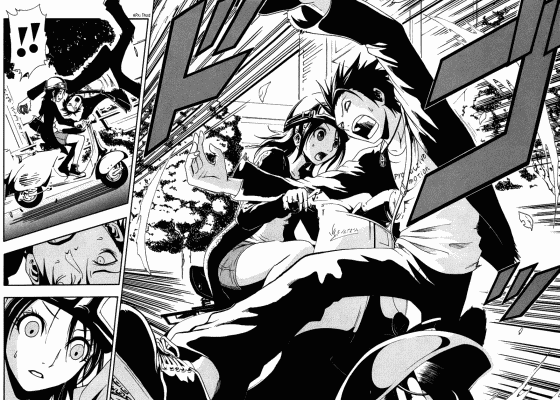
Way to watch the road, Kagura.
I watched Ga-Rei Zero despite numerous warnings from various people not to. They alleged the show is terrible, but I was willing to hazard that to find out what the deal is with Yomi. I won't tell you much about Yomi, but I will tell you people were wrong about the anime being terrible. I can understand why some people don't like it, though. First, Ga-Rei Zero pulls the rug out from under the viewer numerous times. [Spoiler: The lesbianism is a lie.] Moreover, the show does not take itself too seriously, and borders on self-parody on a few occasions. I can understand that some may also dislike the shifts in tone, but I rather enjoyed them. Finally, some complain the anime isn't true to the manga. Those complaints I don't really understand.

I like the art in the manga more than the covers.
I've started reading the Ga-Rei manga. (The Ga-Rei Zero anime is a prequel taking place two years prior to the opening chapter of the Ga-Rei manga.) I've completed the first 25 chapters, and I have to say the anime does not stray far from the spirit of the manga. Yes, there are notable differences, particularly in that the manga is told from the perspective of a male lead. I almost dropped the manga early on because I thought he was another shounen jive male protagonist, to tell you the truth. But while there is a lot of "I'm just a normal guy...except I can see ghosts" and a little too much "I MUST PROTECT HER!" there isn't much Bleach or Index-type exposition. Mercifully, the manga also does not take itself too seriously, and there are a lot of tongue-in-cheek jabs (including a ridiculous first kiss). There are even some tanuki jokes I know at least one person will appreciate. There's also some well-drawn fan service to go along with the admittedly shounen jive overall plot. My only real complaint with the manga is that the comic timing seems a little off. I can see the framework for the jokes, but the effect loses a little something in the translation. I suspect Ga-Rei likely reads a bit funnier in the original Japanese, but that's just speculation on my part. Oh, it also needs more Yomi, alas.
Posted in Ga-Rei, Ga-Rei Zero, Manga | Tags: Built for Sin, Girls With Guns, Hair, Hime Cut, Shounen Jive | Permanent Link
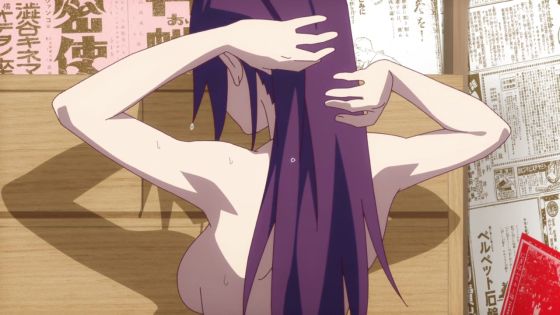
Hitagi doesn't believe in towels. Well, she believes they exist.
I am only following four new shows this summer: Bakemonogatari, Canaan, Taisho Yakyuu Musume, and Zan Sayonara Zetsubou Sensei. The rest of the shows I'm watching are all continuations of series that began previously (I'm including the second season of Suzumiya Haruhi no Yuuutsu in this group). I'm told there are a number of other shows airing this season that are also worth watching, but I've got enough on my plate for now.
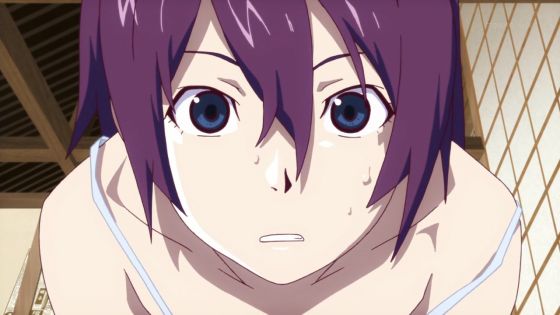
It's still a hime cut. Okay?
Among these shows, Bakemonogatari, Canaan, and Taisho Yakyuu Musume are closely ranked and trade positions episode to episode as far as my favorite new show of the season goes. Each has managed to surprise me in some way—enough to boost them beyond my expectations.
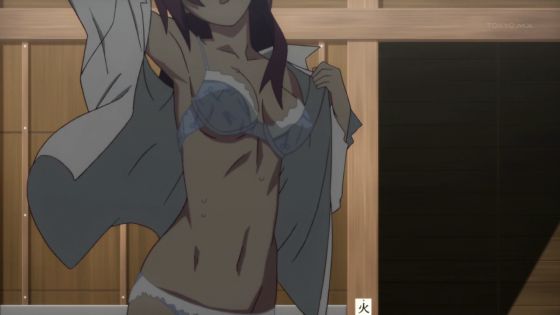
Hitagi can eat whatever she wants and never gain a pound. [Spoilers.]
Regarding Bakemonogatari, I'm glad to see such overt fan service presented proudly and unapologetically. I mean, Queen's Blade has overt fan service also, but you can tell the animators knew they weren't making anything that was ever going to be held up in a serious light and admired by port-drinking ass clowns knowingly rubbing their chins. Bakemonogatari, on the other hand, at least tries to present itself as something better than what we groundlings deserve.
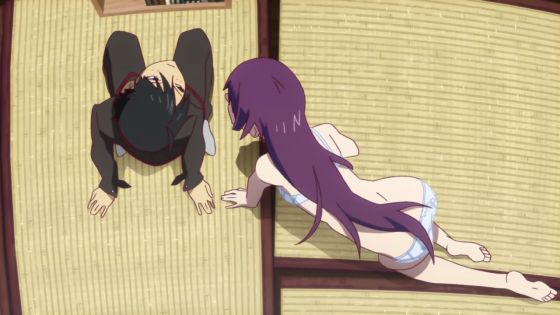
I'm going to pretend Araragi ran in terror and refused to look
directly at Hitagi because he has vampire eyes. [Spoiler.]
Either that or he's an anime male protagonist.
Bakemonogatari has also been described as insufferably smug and self-important; this is true, but it's okay. As much as I often lament that radio dramas almost never get translated, even I grew a little tired of the extended telephone conversation segment—and this from a guy who really likes the infamous elevator ride in Neon Genesis Evangelion. But the show wins me over with with the little gimmicks and twists that I won't spoil here. Bakemonogatari is flawed, but it has enough good points to still make it worth your while.
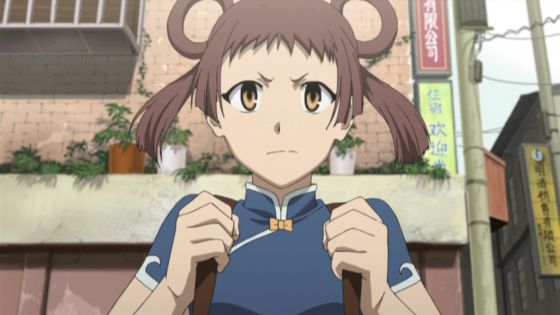
You can't fault Yun-Yun's work ethic. Or her taste in clothes.
Canaan is a much more conventional show, but keeps my interest because of its high production values and (so far) somewhat opaque story. Others have complained they don't feel particularly invested in the characters because they don't know too much about them and aren't entirely sure what's going on, but I am certainly not going to fault a series for not being predictable with cookie-cutter characters. It might turn out that Canaan isn't so special after all, and the lack of information is a fault of clear storytelling and not a sign of something grander below the (very pretty) surface, but I'll give it a chance. Also Yun-Yun is a fun character. At a minimum, I'll keep watching just to see where her story goes.
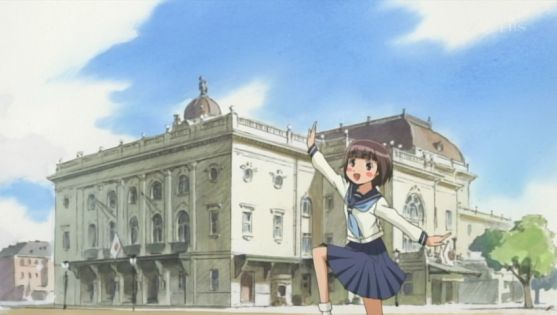
There should be a musical number with different characters every episode.
Taisho Yakyuu Musume is about what I expected from a J.C. Staff production about girls playing baseball in 1925. Not a model of historical accuracy by any stretch of the imagination, but charming and entertaining nonetheless. I hope to see more rickshaw training and musical numbers, to tell you the truth. Of course, I've been waiting for an all-singing, all-dancing Love Hina OVA ever since I heard "Mirai e no Okurimono." I guess that's never going to happen, so I wouldn't hold your breath when it comes to getting more musical numbers in Taisho Yakyuu Musume.
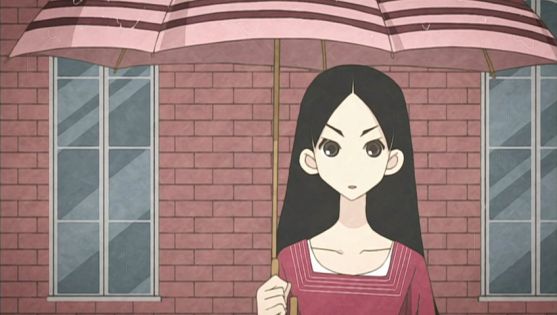
It's asymmetrical without someone on the other side of your umbrella, Chiri.
Sadly, I'm not as taken with Zan Sayonara Zetsubou Sensei. It's possible that I've just grown tired of its gimmicks, but each succeeding season of Sayonara Zetsubou Sensei has seemed less interesting to me than the one before. I really enjoyed the first season, but now I think I would enjoy Zan Sayonara Zetsubou Sensei more if the episodes were half-length to fill 15-minute blocks instead of a full half-hour ones. It's probably also because the characters, by design, are heavy stereotypes. This is probably why I like Nami (the Normal one) more and more as time goes by. I'm not quite willing to move shovel-wielding Kitsu Chiri from the Best Girl top spot, though.
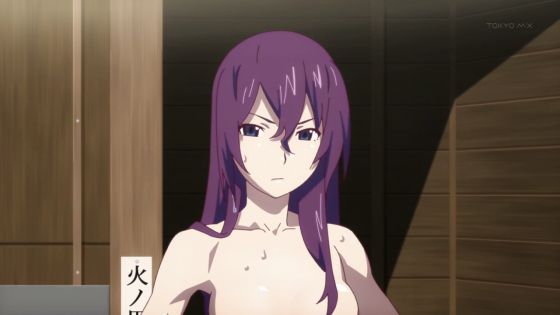
Where we're going, we don't need dere-dere.
Notably, I haven't dropped any shows this season and I don't expect to drop any of the above four—at least barring some catastrophically poor shifts in quality, which generally doesn't happen this late in the game. I've already seen four or five episodes of each of these shows, so they're probably in the clear. The only one really at risk is Bakemonogatari, and that's just because I'm not a fan of SHAFT X SHINBO. I'll remain appeased as long as Hitagi remains kinda mean, though.
Posted in Bakemonogatari, BEST GIRL, Canaan, Season Summary, Taisho Yakyuu Musume, Zan Sayonara Zetsubou Sensei | Tags: Built for Sin, Hair, Hime Cut, Legs that go up to her neck, SHAFT X SHINBO, Superlovely Character Designs, tsundere | Permanent Link
|
|

































